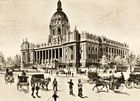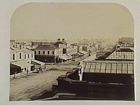Gold was the cause of the great expansion of Melbourne from 1850. The major gold fields were inland, though some gold was discovered in 1850 at Anderson's Creek, near Warrandyte. The Melbourne that greeted the tide of gold immigrants had 23,000 residents and was thus far more established than for example San Francisco at the time of the discovery of gold in California, which had only about a thousand residents. Nevertheless, the rapid influx of people was more than any small city could adequately house or care for in the short term – historian Geoffrey Serle referred to the earlier 1850s as the ‘crisis years’. In just four months in 1852, 619 ships arrived in Hobson's Bay, carrying 55,057 passengers; 1853 saw the arrival of 2,594 ships. At Sandridge (Port Melbourne) many, learning the high price of transport and storage, tried to sell excess possessions, or simply abandoned them on the beach. Most of the incoming gold seekers would leave Melbourne within a few days for the diggings, complaining of the roughness of the town and the astonishing prices of all the necessities of life.
Multimedia Content

Parliament House, courtesy of State Library of Victoria.
Details
A narrated sequence about Melbourne, courtesy of British Parliamentary Papers.
Details
Where is Melbourne located?
Details
Thomas Coggan recalls Melbourne as being a less than golden city, courtesy of Private (Robyn Annear).
Details
Canvas Town, 1850s, by De Gruchy & Leigh, courtesy of State Library of Victoria.
Details
Collins Street, Melbourne, 1858, by Fauchery, Antoine (1823 - 1861), Daintree, Richard (1832 - 1878), courtesy of State Library of Victoria.
Details
Forecourt of the State Library of Victoria, c. 1864 - c. 1870, courtesy of State Library of Victoria.
Details
The Golden Metropolis: Overview
Details
The pressure of the incoming population was initially felt most strongly south of the Yarra River. Business and land prices in Port Melbourne grew rapidly until the first suburban railway linked Melbourne and Sandridge in 1854, which brought the area into more direct business competition with the city. Several thousand new immigrants lived in tents in Canvas Town, described by Antoine Fauchery as 'a floating city devoured by the sun, inundated by the rain and swept away by the wind'. The first such tent settlement was on Emerald Hill in South Melbourne, then a larger one grew up from 1852 near Princes Bridge on the southern side of the river and the western side of St Kilda Road. Disease was common there, and in 1853 a fever epidemic hit. By 1853, many thousands of immigrants had also been temporarily housed in several Immigrants Homes built with contributions from government, the churches, and public subscription. More permanent though rapidly-built housing sprang up rapidly in suburbs such as South Melbourne, Port Melbourne, Prahran, Richmond, Collingwood, Fitzroy and North Melbourne, but the housing crisis took many years to ease. As men rushed out of the city to the gold fields, many commentators noted that Melbourne seemed for a time to be a city of women. There was particular concern about the moral and economic facing 'deserted wives', left to support themselves by men who had gone upcountry and not returned.
The population of Melbourne grew from 29,000 in 1851 to 123,061 in 1861. Gold provided the wealth and the confidence about the future which stimulated the construction of several important city buildings — in 1856 an architectural critic called Melbourne a city of ‘magnificent intentions’. Work began on the Public Library (see State Library of Victoria) and the University of Melbourne in 1854, the Victorian Parliament House in 1856, and the Treasury Building in 1857. A writer in that year commented that Melbourne was now a city ‘filled with substantial indications of permanence’. By 1861 Elizabeth Ramsay-Laye considered Melbourne 'a stately city … lavishing her gold on everything that will beautify and adorn her, and give her a place among the cities of the Old World'. In Melbourne the transformation of the ‘instant city’ of the early gold rush into something more permanent and ambitious was itself also a rapid process.
The census of 1851 revealed that about a third of the population of the city was 14 years of age or under, and about half were 21 or younger. Only about 7% of males and 5% of females in Melbourne were 45 years old and over. Gold continued an existing demographic imbalance — the proportion of the population which was female was about 38% in 1846, 40% in 1854, and 35% in 1857.
The gold-rush immigrants, so many of them young men away from home for the first time, caused the theatre in Melbourne to flourish. George Coppin's Olympic Theatre and his Theatre Royal both opened in 1855, to join the existing Queen's Theatre. They were very large venues — the Theatre Royal held 3000, and Astley's Amphitheatre seated over 2000. Enthusiastic diggers throwing coins or 'pinches of gold dust and small nuggets enveloped in a fragment of a newspaper' on to the stage became part of the subsequent popular memory of gold-rush Melbourne.
Gold seemed to give a particular urgency to the work of cultural institutions, and institutions of rational recreation and religion. The Public Library was open until 9pm. Mechanics Institutes opened in Melbourne and many of its suburbs in the 1850s. The National Museum of Victoria (see Melbourne Museum) aimed to instruct about the natural world of the new colony. All of the churches struggled to provide accommodation and clergy for the increased population. On the other side of the ledger, hotels opened all through the city. An 1856 police inquiry found 63 ‘houses of ill-fame’ and 198 prostitutes working within the city.
The Victoria Police was established in 1853. That year, Inspector Freeman and 50 constables arrived from London to reinforce the local force and to bring their experience of the London beat system. In August 1855, Chief Commissioner Charles McMahon requested sketches of the different beats, ‘with the various blocks coloured differently and arrows pointing in the directions in which the constable should go’. Disorder in Melbourne more than serious crime troubled the police, and a visible presence of uniformed police seemed the way to combat it.
Gold brought immigrants from many nations, among them the Chinese, peculiarly subject to discrimination. A Committee of the Victorian Legislative Council argued in 1857 that ‘the Chinese migrate to this country exclusively to mine for gold’ – as if that distinguished them from much of the rest of the population. Gold-rush Melbourne produced newspapers published in languages including German and Welsh. There were Americans, and immigrants from all over Europe resident in the city, but the gold-rush immigrants came most numerously from England, Ireland, Scotland, China and Germany.
Gold brought great wealth to some in Melbourne, but it also – like the pastoral industry – contributed to the dominance of a kind of import/export commercial economy, centered around the trade of the port. 'The gold rushes of the 1850s', argued historian Graeme Davison, 'confirmed the city's commercial destiny'. Economic historians have argued that in Melbourne, urbanisation stimulated industrialisation, rather than the other way around – 'the city took on its own momentum', argued Ian Turner, 'it attracted people to it to satisfy the market's needs'. Gold was clearly one of the major factors that contributed to that pattern of development.
Gold facilitated the extraordinarily rapid settlement of Melbourne and its hinterland. For the Aboriginal peoples of the region, coming on top of the rapid expansion of the pastoral industry on their land, it was a cruel development. It is difficult to imagine any other event which would have sent the invaders so rapidly and so single-mindedly into the interior. One consequence was the regathering of larger numbers of Aboriginal people in and around Melbourne itself. William Thomas, Guardian of Aborigines, reported in 1854 that the condition of the Aborigines had ‘lamentably deteriorated’ – ‘the discovery of gold has greatly affected their moral condition’, and they were only ‘with great difficulty kept from the town itself’.
- References
- Argus, 24 February 1852, p. 4. Details
- 'Victoria 150 years of gold. special issue', Victorian Historical Journal, vol. 72, no. 1-2, September 2001. Details
- Goodman, David, Gold seeking: Victoria and California in the 1850s, Allen & Unwin, St Leonards, 1994. Details
- Serle, Geoffrey, The golden age: a history of the colony of Victoria, 1851-1861, Melbourne University Press, Melbourne, 1963. Details

